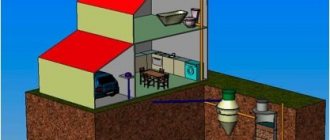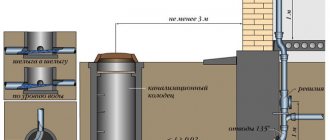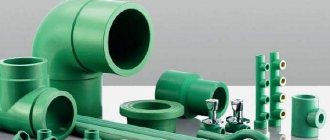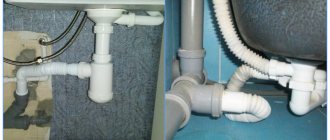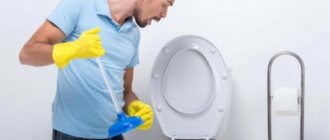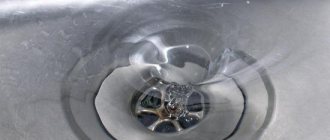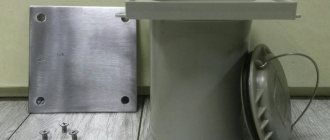Among the many options, hydrochloric acid for sewer cleaning stands out for its radical and harsh mode of action. Typically, this method is used in extreme cases when other means have not helped. Supporters and opponents of this method have endless debates about the advisability of such experiments.
The main arguments of the parties contradict each other, and reality does not confirm either one or the other argument. However, the correct application of this method can solve emerging problems. Let's take a closer look at the technology of such sewer cleaning.
Causes of blockages
The sewer system moves wastewater with a high content of organic matter and fats. They stick to the walls in a thin layer, which gradually grows and turns into a full-fledged blockage. As a rule, it is located near the drain hole of kitchen sinks or other plumbing fixtures. Most often, the siphon suffers from fat deposits, the bend of which actively collects sticky and viscous components of wastewater.
In addition, a common cause is foreign objects falling into the sewer. There may be hair, paper, construction waste (sand, residues of adhesive solutions), feminine pads and other unwanted components. They get stuck in bends or narrowing areas of the pipes, causing permanent blockages. No methods other than mechanical cleaning give results.
On cast iron pipes, there are cases of scale detachment from the inner surface of the walls. It remains inside and quickly becomes overgrown with fat, trapping small particles of organic matter. Mechanical cleaning of pipes will also be a solution to the problem.
Prevention
To prevent the drain from becoming completely clogged, it is necessary to carry out preventive work in a timely manner (they mainly relate to prevention in the kitchen).
The easiest way to prevent blockages is to pour boiling water into the pipes every day.
And also follow the recommendations of plumbers:
- do not pour fatty liquids into the kitchen sink;
- Throw any leftover food from the dishes into the trash bin before washing;
- to protect against small food debris or hair getting into the drain, it is necessary to install a special protective mesh;
- do not throw hair from the comb into the washbasin or toilet;
- Every day you should fill the drain hole with boiling water.
You can clear clogged pipes yourself. The main thing is to choose the right methods. These are both mechanical cleaning options and chemical ones to combat old traffic jams. Folk tricks will help with minor traffic jams. But there is nothing better than timely prevention. And then you won’t have to become an amateur plumber too often.
Remedies
The most effective methods include mechanical cleaning. It is simple and easy to do yourself. A plumbing cable is used, which is inserted into the pipe and pushed inside with rotational movements.
When contact with the blockage occurs, the cable tip destroys the plug. After this, the internal cavity of the pipelines is washed with a strong stream of water.
There is hydrodynamic cleaning. It is produced using special equipment. The essence of the method is to immerse a thin hose with a special tip, from which a stream of water shoots out under strong pressure. The effectiveness of this method is higher than that of alternative types of cleaning.
The use of chemicals, as a rule, is carried out only to clean the internal areas of the system. There are many formulations on sale that contain alkaline or acidic components. Sometimes drain cleaning with hydrochloric acid is used. This is an extremely dubious and dangerous method that can do more harm than good.
Using regular salt and soda
If there are no means at hand, salt is often used to clean the drain. It is poured generously into the drain hole and left for some time. Salt eats away fat deposits and makes them loose. After some time, the siphon is washed with a strong stream of water, removing organic particles.
To enhance the effect, make a mixture of soda and salt. The proportions vary, but the effect is usually the same. Please note that regular baking soda is not suitable. You need a caustic that can effectively interact with fats. In addition, caustic soda can dissolve more complex blockages. For example, hair that does not interact well with most chemicals.
However, this method is only suitable for blockages located near the drain. If the problem section of the pipe is further away, more radical remedies are needed.
Special chemicals
Mr. Muscle
The powder does a good job of removing clogs and disinfecting the surface of the pipe. Pour the contents of the bag into the pipe, and carefully pour the powder with a glass of warm water. After half an hour, rinse the drain thoroughly. One bag is enough to deal with the blockage, and it costs no more than 100 rubles.
This is a very inexpensive domestic product that can be used to remove completely different blockages. Pour in 200-250 ml. into the drain and leave the product for 2 hours. After the specified time has passed, rinse the pipe with strong water pressure. If the blockage cannot be cleared the first time, use the product again. Mole costs much less than imported analogues, no more than 70 rubles.
Pothan
Before use, lower the water level in the drain by 5 cm. Then fill in 100 ml. products and 100 ml. boiling water After 5 minutes, rinse the drain with warm water. The product is suitable for all blockages in cast iron and plastic pipes.
Pour the product into the drain and add hot water. The required proportions are indicated on the packaging. Then rinse the drain thoroughly with cold water. The product is very caustic, so put on gloves, a respirator and a protective apron or special suit before using it.
There are methods that will help get rid of a blockage in the pipe. You can implement them at home without much expense, since everyone has the proposed materials and tools. However, they are not suitable for every case and are not always effective.
This option is the simplest. All you need is boiling water and coarse salt. Can be used to clean cast iron non-separable siphons in the kitchen sink. You can add citric acid as an enhancer.
- If there is any water left, remove it and dry the sink.
- Pour 200 g of salt into the drain hole ("extra" is not suitable).
- Pour two liters of boiling water into the drain.
- Wait 30 minutes and check the result.
- If necessary, repeat the procedure.
This method is not suitable for cleaning plastic pipes (due to their sensitivity to temperatures of 1000C), as well as for bathtub and toilet drains. The reason is that salt and boiling water are effective only against fatty plugs; they cannot cope with mechanical blockages.
We suggest you read How to remove stains from clothes at home
It’s not for nothing that this method is called environmentally friendly - it is not harmful to the person who uses it and to pipes. You will need baking soda, white vinegar and boiling water. Also have a rag or sponge ready to cover the drain hole.
- Pour half a pack of dry soda down the drain.
- Pour 0.5 cups of preheated vinegar
- Cover the drain with a rag or sponge so that the reaction between vinegar and soda occurs inside the pipes.
- Leave everything for half an hour.
- Pour 1.5-2 liters of boiling water into the drain.
After this procedure, the water should drain easily. The method is especially useful when forming a fat plug in remote places of communications.
This method is similar to expensive pneumatic cleaning, but uses a vacuum cleaner with a blowing function. To ensure that the pipe fits tightly into the drain, wrap it with a rag. Turn on the vacuum cleaner at full power and the air flow will push even complex blockages through the pipe.
To remove the blockage, you can use ready-made products. You can find them in any household chemical store. The table shows the most effective ones, according to reviews from housewives.
| Name | Purpose | Instructions for use |
| "Mole" | Fighting blockages in the sink, bathtub, toilet | Pour 200-250 g of product and leave for 2 hours. Drain off the water generously. For prevention use once a month |
| "Debouche" | Removing fatty and mechanical blockages in sewer pipes | Pour 0.5 liters of liquid into the drain and leave for 2 hours. If the blockage is severe, pour 1 liter overnight. After the procedure, rinse the pipes with plenty of water. |
| Bagi "Pothan" | Removes any blockages in plastic and cast iron pipes | Lower the water level in the drain by 5 cm, carefully pour in 100 g of product and the same amount of boiling water. After 3 minutes, drain the water thoroughly. |
When working with Bagi “Pothan”, be careful, pour liquids from an outstretched arm and turn your head to the side to avoid chemical burns.
Manufacturers of household chemicals offer a wide selection of special products:
- liquid (for example, “Tiret” (without the smell of ammonia), “Mr. Muscle” (with the smell of ammonia) - act gently on the material, but remove blockages effectively, especially in plastic);
- powders (for example, “Komet” - not always convenient to use, especially if the water does not drain completely);
- acidic (for example, “Mole”);
- alkaline (for example, “Belizna”, “Domestos”).
Despite the advertising, these products (especially alkaline and acidic ones) in practice should not be used frequently for cleaning plastic pipes. Moreover, on the Internet you can find thousands of “horror stories” about how the “Mole” corroded a pipe. Of course, a lot depends on the quality of the plastic, but nevertheless, using chemicals more than once a month is not recommended.
Pipe cleaners are included in the product lines of all major household chemical manufacturers
Application of hydrochloric acid
Hydrochloric acid is a reliable fat solvent. At the same time, it is a dangerous and aggressive chemical composition. It can cause considerable harm to pipelines and people cleaning them.
Many users doubt whether it is possible to clean drains with hydrochloric acid. Their fears are quite reasonable:
- the composition is capable of corroding cast iron pipes. For residents of apartment buildings, this is a very real danger, since almost everywhere in the basement the sewage system is cast iron;
- acid vapors have a negative effect on the organs of vision, breathing, and human skin. The use of protective equipment and enhanced ventilation of the room is required;
- Cleaning the sewer with acid is done blindly. The apartment owner simply pours a large amount of acid into the drain hole and waits for the result. It cannot influence in any way the quality or efficiency of the process;
- Instead of cleaning and removing the blockage, you may end up with leaks in the cast iron parts of the system, which will require serious repairs. However, the original problem will remain.
Some sources recommend using hydrochloric acid with a concentration of no more than 3-10%. In their opinion, this will help protect cast iron pipes from contact with aggressive chemicals. However, it is clearly not possible to dissolve fat deposits from many years ago in this way.
Important
There is one more important point. Acid is poured into the plumbing drain hole. If there is water in the siphon, the concentration will drop sharply and the expected result will not be obtained. If you remove water before flushing the sewer with hydrochloric acid, the composition will only pass through the lower part of the pipelines. There will be no impact on the top of the pipe lumen. It is unrealistic to pour such an amount of chemical into the system to completely cover the section. This raises doubts about the effectiveness of the technique.
Proponents of sewer cleaning using similar methods proceed from general ideas about the properties of materials. They do not take into account the multiple factors that reduce the effectiveness of the composition. Hydrochloric acid for drain cleaning gives the desired effect only at a fairly high concentration. However, the density of the solution is difficult to maintain in the desired state. Residual water in the pipes significantly reduces the concentration of the composition. The only component of the system that receives fairly complete contact with the acid is the siphon.
However, it is easier to disassemble and perform mechanical cleaning. It will take much less time and will not require noticeable effort.
You may also like:
How to clean the drain and remove the blockage with your own hands
Cleaning sewer wells: methods and techniques
Physical state of drugs
Among the many products containing alkali for cleaning pipes, the following groups can be distinguished:
1. Dry preparations, which are powdered products (granules) packaged in bags. Their main advantage: small volume.
2. Gel-like substances. A number of properties put these drugs in one of the first places in popularity:
- low cost;
- fluidity, which promotes uniform distribution along the entire length of the pipe;
- high functional efficiency. As a result, the plugs are completely dissolved and the entire internal area of the pipe is cleaned.
3. Liquids. Most often they are used when powder or gel substances are not able to cope with very complex fat plugs.
Important! Always read the instructions before using any clog remover.
Although, if you analyze the texts of the instructions, most of the tools are universal. That is, they can be used to remove any contamination from plastic pipes, both in apartments and in country houses or cottages.
Step-by-step instruction
Before cleaning the drain with hydrochloric acid, it is necessary to prepare personal protective equipment. In addition, it is necessary to organize enhanced ventilation of the room. Procedure:
- pour a chemical composition into the drain hole. Hydrochloric acid is fed into the sewer carefully, in a thin stream, so as not to splash around. It should be enough for the solution to travel as far as possible through the pipe;
- stand for a certain time. We recommend covering the drain hole with a lid, rag or other object. The composition should be kept for as long as possible and for at least half an hour;
- release a strong stream of water and rinse the pipe cavity well.
Sometimes sulfuric acid is used instead of hydrochloric acid to clean drains. Cleaning the system in this way is even more dangerous, since sulfuric acid vapors are highly concentrated. In addition, it is effective only in high concentrations, which makes its use unreasonably dangerous.
Useful tips
True professionals willingly share their experience in cleaning pipes from blockages that may arise during pipeline operation. If you listen to their recommendations, the cleaning procedure will be easy and safe, and the system itself will serve for a long time and with high quality.
- You cannot neglect any point in the instructions for chemical preparations; you must accurately use the exposure time of the reagent. Otherwise, the process of destruction of the material from which the pipeline is made may begin.
- After carrying out the cleaning procedure yourself, the remaining reagents should be washed out with plenty of hot water, which will save the system for many years.
- Carefully read all texts on the packaging of the product. It may happen that you accidentally purchased a prophylactic drug, in which case it is used only for minor contamination of the system.
- “Eliminates fatty deposits in standing liquids” - this should be approximately the inscription on the packaging of products that can remove significant fatty plugs.
Important! It is necessary to choose the exact chemical depending on the type of blockage. This means that in some cases it is necessary to use weakly active substances. And vice versa: if there are “powerful” fatty deposits, then you need to use a potent drug.
Video
Precautionary measures
Since the reagent has a strong corrosive ability and releases toxic fumes when interacting with air, it is very important to use protective equipment when working with it.
When contacted with the skin and mucous membranes, the material causes chemical burns, and with prolonged exposure to an HCl atmosphere, tooth decay occurs, catarrh of the respiratory tract develops, and ulceration of the nasal mucosa occurs.
For protection purposes, it is necessary to use a gas mask, a rubberized apron, goggles and rubber gloves. Carry out work only in well-ventilated areas. If the reagent gets on your skin or mucous membranes, rinse the affected area with plenty of running water and seek medical help.

